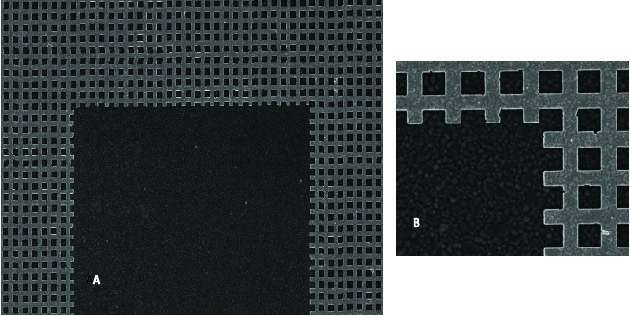October 27, 2016 by A'ndrea Elyse Messer

Infrared image of metadevice composed of vanadium dioxide with gold patterned mesh. (Top) Device without any electric current showing the PSU cut from the pattern and reflective. (Middle) Device with 2.03 amps of current. The PSU and background now appear the same, the PSU has faded into the background. (Bottom) Device with 2.20 amps of current. The background is now reflective while the PSU is not. Credit: Douglas Werner / Penn State
An electric current will not only heat a hybrid metamaterial, but will also trigger it to change state and fade into the background like a chameleon in what may be the proof-of-concept of the first controllable metamaterial device, or metadevice, according to a team of engineers.
"Previous metamaterials work focused mainly on cloaking objects so they were invisible in the radio frequency or other specific frequencies," said Douglas H. Werner, John L. and Genevieve H. McCain Chair Professor of electrical engineering, Penn State. "Here we are not trying to make something disappear, but to make it blend in with the background like a chameleon and we are working in optical wavelengths, specifically in the infrared."
Metamaterials are synthetic, composite materials that possess qualities not seen in natural materials. These composites derive their functionality by their internal structure rather than by their chemical composition. Existing metamaterials have unusual electromagnetic or acoustic properties. Metadevices take metamaterials and do something of interest or value as any device does.
"The key to this metamaterial and metadevice is vanadium dioxide, a phase change crystal with a phase transition that is triggered by temperatures created by an electric current," said Lei Kang, research associate in electrical engineering, Penn State.

Scanning electron microscope image of gold patterned mesh used in metadevice.(A)is the top portion of the U cutout. (B) is a magnified look at the mesh from the same area. Credit: Douglas Werner / Penn State
The metamaterial is composed of a base layer of gold thick enough so that light cannot pass through it. A thin layer of aluminum dioxide separates the gold from the active vanadium dioxide layer. Another layer of aluminum dioxide separates the vanadium from a gold-patterned layer that is attached to an external electric source. The geometry of the patterned mesh screen controls the functional wavelength range. The amount of current flowing through the device controls the Joule heating effect, the heating due to resistance.
"The proposed metadevice integrated with novel transition materials represents a major step forward by providing a universal approach to creating self-sufficient and highly versatile nanophotonic systems," the researchers said in today's (Oct. 27) issue of Nature Communications.
As a proof of concept, the researchers created a .035 inch by .02 inch device and cut the letters PSU into the gold mesh layer so the vanadium dioxide showed through. The researchers photographed the device using an infrared camera at 2.67 microns. Without any current flowing through the device, the PSU stands out as highly reflective. With a current of 2.03 amps, the PSU fades into the background and becomes invisible, while at 2.20 amps, the PSU is clearly visible but the background has become highly reflective.
The response of the vanadium dioxide is tunable by altering the current flowing through the device. According to the researchers, vanadium dioxide can change state very rapidly and it is the device configuration that limits the tuning.
More information: Liu Liu et al. Hybrid metamaterials for electrically triggered multifunctional control, Nature Communications (2016). DOI: 10.1038/ncomms13236
Journal reference: Nature Communications
Provided by: Pennsylvania State University
Read more at: http://phys.org/news/2016-10-metamaterial-device-chameleon-like-behavior-infrared.html#jCp